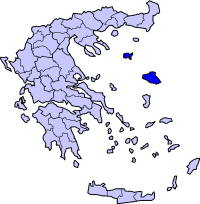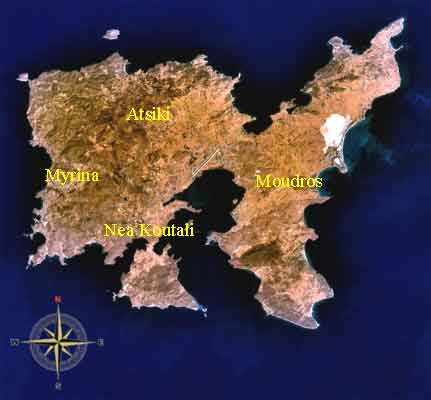.
Administrative Region : North Aegean
Regional unit : Limnos


Panagia (Greek: Παναγία), accented form: Panagía is a Greek village 35 km ENE of Myrina in the municipality of Moudros, Greece. Its 2001 population was 365 people. It is located in the northeast of the island of Lemnos. It is the only place on the whole island that the center lies north of the 40th parallel, parts of it are below the parallel. The island of Imbros in Turkey is just 20 km northeast.
Subdivision
* Kortisona (Κορτισώνας) [2001 pop: 6]
Population
Year Village population Municipal district population
1928 406 -
1938 500 -
1961 697 -
1991 448 -
2001 447 453
Ancient location
In the west of the village, a small port in Sotiras bay in which it known the ancient location. Concentrated to the north of the cape founded an epitaph stele from the 4th century BC and reads: BENDIDORA METROPHANOU GERGISIOU
In older times, the location mentioned as the stream of Agios Sotirios, the chapel Sotira meant in maps as of a chronologer, in which united the work of the Italian traveller Buondelmonti (1418).
In 1521 in the sailor guide and in the maps of the Turkish sailor Piri Reis meaning the anchorage Kilsegük a chapel, in which it meant that it had a small chapel in the area. A coastal settlement known as Sotira northeast of the island was known in mapos of other travellers including Belon (1528) and Dapper (1688).
In 1858, Conze visited the cape and Sotiras lagoon, he observed an old ruined stone pier and the chapel of Agios Sotiras. The old mill began in the cape and built north around 400 m from the sea.
The running of the village
In the mid 19th century, the area of northeast Limnos between Kontopouli and cape Plaka did not had a village. It had only several isolated ciflik groves, which belonged to the Turkish farmers from Anypati.
In that time it had much from the oral tradition as much as the German traveller Conze in which he covered the rest of northeastern Lemnos in 1858.
The village of Panagia was founded around 1865 and 1866 from residents from Agios Ypatios and Kontopouli in which they had businesses in area. Its first settlers was believed to be Komninos Katogoudis, Ioannis Lagos, Emmanouil Paximadas and Dimitrios Tsagdis.
The area was chosen, which was located around an old Byzantine monastery, in the foot of Alepotrypes or Alepotripes (Αλεπότρυπες) hillm believed to be founded in an equal estimated distance from the west and east shores, in which it had a great safety.
19th century
In 1874, it had 30 families. In another work of the same year, Panagia was mentioned as Tsiftlikia (Τσηφτλίκια). Consequently the name Panagia was not still kept.
It is characteristically when in 1894, the village was not mentioned in a map of De Launay as it mentioned as a settlement in a nearby location of Naxia and petsa. Later in 1904 in a map of Friedrich except for the two upper settlements, it meant and Panagia as a separate settlement. Evidently, the village had begun to concentrate some inhabitants.
The monastery
Even from 1865, the first inhabitants had built a monastery of Panagia in the location of an older monastery. The area belonged to some Turkish tsiflik. They tried twice to hinder. Later it built newere temples with a gift of $6,500 by Anastassios (Thomas?) Diamantis, an immigrant from the USA.
The school
Un 1887, afterwards from the common measured of its residents of Panagia and Plaka, it founded a communal school in Plaka in which it had six students from Panagia.
In 1903, it opened its own school with 20 students, it also had a peculiar seating. Concentratedly in 1925, the hald of the teachers were paid by its inhabitants. It later did not had notices about the second level for the remainder of the students attended in Kontopouli.
The school building was built in 1929 and 1932. Later the village school featured its famous alumni including Iordanis Alevropoulos (1946–69), Iraklis Kontellis (1963-;) and Konstantina Kalogianni (1963-;).
The present day
Between World Wars I and II, the village had known in the utmost of Limnos, it build measurably with the aid and the refugee families which settled there. In 1925, it built 80 double refugee buildings. That year it united with a paved road with the rest of the island in which after Kontopouli, it had black gravel.
The village rose in the population, economoically and culturally with high numbers. That rise except for the agricultural production obligated in the works and in compassion of its inhabitants, In 1928, it had 406 people, in 1938 it had 500 and had 125 houses and a two-tier school with 100 students.
After World War I, the agricultural fields produced 407 tons of cotton and 700 tons of wheat. In 1961, it had 697 inhabitants and from 1963 until 1974, it became a three-tier school. Later it had a small decline, the school reduced to a two-level, without having lost the strength of the village. In 1991, it had 448 people.
Today, it operates one of the most living villages on the island. It operates the Plaka-Panagia Fishing Committee, the soccer club Aetos Plaka-Panagia, it has an active cultural council and in Athens, the immigrant union with a remarkable action.
Bibliography
* Tourtsopoulou-Stefanidou Vasilili, Taxidiotika kai geografika keimena gia ti niso Limno (15os-20os aionas) (Ταξιδιωτικά και γεωγραφικά κείμενα για τη νήσο Λήμνο (15ος-20ος αιώνας)' = Travelling and Geographic Sources of Lemnos Island (15th-20th Centuries)) Thessaloniki, 1986.
* Lemnos CD: Limnos agapimeni (Λήμνος αγαπημένη = Loveable Lemnos)
* Theodoros Belitsos, I Limnos kai ta choria tis (Η Λήμνος και τα χωριά της = Lemnos and its Villages), 1994
|
Municipalities and communities of the Lesbos Prefecture
Agia Paraskevi | Agiasos | Atsiki | Eresos-Antissa | Evergetoulas | Gera | Kalloni | Loutropoli Thermis | Mantamados | Mithymna | Moudros | Myrina | Mytilene | Nea Koutali | Petra | Plomari | Polichnitos |
| Municipal unit Moudros |
|---|
| Municipal Community Moudros |
| Κουκονήσιο, το (νησίς) |
| Moudros (Μούδρος, ο) |
| Community Kalliopi |
| Kalliopi (Καλλιόπη, η) |
| Community Kaminia |
| Voroskopos (Βοροσκόπος, ο) |
| Kaminia (Καμίνια, τα) |
| Community Kontopouli |
| Agios Alexandros (Άγιος Αλέξανδρος, ο) |
| Agios Theodoros (Άγιος Θεόδωρος, ο) |
| Kontopouli (Κοντοπούλιον, το) |
| Community Lychna |
| Anemoessa (Ανεμόεσσα, η) |
| Lychna (Λύχνα, τα) |
| Community Panagia |
| Kortisonas (Κορτισώνας, ο) |
| Panagia (Παναγία, η) |
| Community Plaka |
| Plaka (Πλάκα, η) |
| Community Repanidi |
| Kotsinas (Κότσινας, ο) |
| Repanidi (Ρεπανίδιον, το) |
| Community Roussopouli |
| Roussopouli (Ρουσσοπούλιον, το) |
| Community Romano |
| Romano (Ρωμανόν, το) |
| Community Skandali |
| Skandali (Σκανδάλιον, το) |
| Community Fisini |
| Agia Sofia (Αγία Σοφία, η) |
| Fisini (Φισίνη, η) |
| Ancient Greece
Science, Technology , Medicine , Warfare, , Biographies , Life , Cities/Places/Maps , Arts , Literature , Philosophy ,Olympics, Mythology , History , Images Medieval Greece / Byzantine Empire Science, Technology, Arts, , Warfare , Literature, Biographies, Icons, History Modern Greece Cities, Islands, Regions, Fauna/Flora ,Biographies , History , Warfare, Science/Technology, Literature, Music , Arts , Film/Actors , Sport , Fashion --- |
Retrieved from "http://en.wikipedia.org/"
All text is available under the terms of the GNU Free Documentation License



